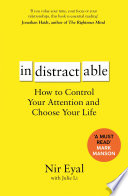
Indistractable
Nir EyalHow to Control Your Attention and Choose Your Life
18 min

In 'Indistractable', Nir Eyal starts by defining what distraction truly is. He distinguishes between external distractions (like notifications and social media) and internal distractions (like boredom and anxiety). Understanding this duality is crucial because it allows individuals to recognize that distractions often stem from deeper psychological issues. By addressing these internal triggers, individuals can develop strategies to manage their attention more effectively. Eyal emphasizes that distraction is not merely a nuisance but a symptom of an underlying issue that needs attention. By learning to identify and confront these triggers, readers can begin to take control of their focus and productivity.
Continue readingEyal argues that being indistractable begins with understanding one’s values. He encourages readers to reflect on what truly matters to them and to align their actions with these values. This alignment creates a sense of purpose that can counteract distractions. When individuals are clear about their values, they are more likely to resist temptations and distractions that do not serve their goals. Eyal provides practical exercises to help readers articulate their values and integrate them into their daily lives, making it easier to prioritize tasks that align with their long-term objectives.
Continue readingOne of the core components of becoming indistractable is mastering time management. Eyal introduces the concept of 'timeboxing', where individuals allocate specific time slots for tasks, including leisure and relaxation. This technique not only helps in managing time effectively but also reduces the anxiety associated with unfinished tasks. By creating a structured schedule that includes breaks and personal time, individuals can maintain focus while also ensuring they have time for rejuvenation. Eyal emphasizes that a well-planned day can significantly reduce the likelihood of distractions.
Continue readingEyal discusses the significance of one's environment in fostering focus. He suggests that individuals can design their environments to minimize distractions. This includes both physical spaces and digital environments. For instance, turning off notifications, using website blockers, and creating a dedicated workspace can help in maintaining concentration. Eyal also highlights the importance of social environments, encouraging readers to communicate their needs to those around them. By setting clear boundaries and expectations, individuals can create a supportive atmosphere that enhances focus.
Continue readingWhile technology is often blamed for distractions, Eyal presents a nuanced view. He argues that technology itself is not the enemy; rather, it is how we use it that determines its impact on our focus. Eyal encourages readers to leverage technology to enhance productivity rather than detract from it. This involves being intentional with tech use, such as setting specific times for checking emails or social media. By taking control of technology, individuals can transform it from a source of distraction into a tool for achieving their goals.
Continue readingEyal emphasizes the importance of building resilience against distractions. He introduces the concept of 'mental contrasting', where individuals visualize achieving their goals while also considering potential obstacles. This practice not only prepares individuals for distractions but also strengthens their resolve to stay focused. Eyal provides strategies for developing grit and perseverance, which are essential for maintaining focus in a world filled with distractions. By cultivating resilience, individuals can navigate challenges more effectively and remain committed to their tasks.
Continue readingThe final key idea revolves around the science of habit formation. Eyal explains how habits are formed and how they can be changed. He introduces the '4-step model' of habit formation: trigger, action, reward, and investment. By understanding this model, individuals can identify the triggers that lead to distractions and replace them with more productive habits. Eyal provides actionable steps for breaking bad habits and establishing new ones that align with one’s values and goals. This process of habit change is essential for becoming indistractable.
Continue readingThe reading time for Indistractable depends on the reader's pace. However, this concise book summary covers the 7 key ideas from Indistractable, allowing you to quickly understand the main concepts, insights, and practical applications in around 18 minutes.
Indistractable is definitely worth reading. The book covers essential topics including Understanding Distraction, The Importance of Values, Time Management Techniques, providing practical insights and actionable advice. Whether you read the full book or our concise summary, Indistractable delivers valuable knowledge that can help you improve your understanding and apply these concepts in your personal or professional life.
Indistractable was written by Nir Eyal.
If you enjoyed Indistractable by Nir Eyal and want to explore similar topics or deepen your understanding, we highly recommend these related book summaries:
These books cover related themes, complementary concepts, and will help you build upon the knowledge gained from Indistractable. Each of these summaries provides concise insights that can further enhance your understanding and practical application of the ideas presented in Indistractable.